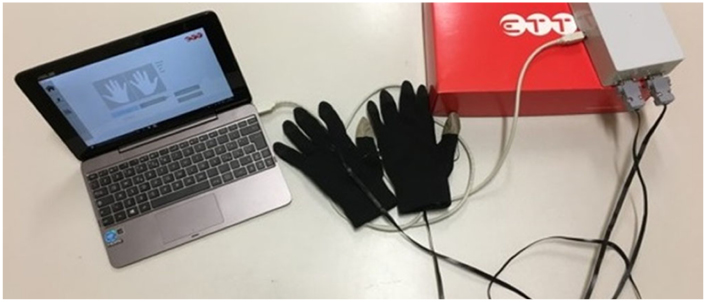BACKGROUND AND AIMS
Charcot-Marie-Tooth (CMT) disease is the most common hereditary neuropathy.1 It is caused by multiple genetic mutations, but the typical symptomatology mainly involves the feet in the lower limbs and the hands in the upper limbs.2 The fact that this condition is rare implies that there is not an abundance of rehabilitative indications in the literature, especially regarding the functionality of the upper limbs and the progression of impairment over time. Moreover, there are few validated measurement tools, and they often have limitations. The aim of this work was to analyse the characteristics of the CMT hand, monitoring the evolution in time and demonstrate the responsiveness of an innovative tool to evaluate the hand function: the hand test system (HTS; Figure 1).3

Figure 1: Hand Test System: an engineered glove that can be used to assess hand dexterity.
METHODS
The authors analysed the hands of 105 patients with a diagnosis of CMT. Assessment took place at the authors integrated outpatient clinic for hereditary neuropathy (Policlinico San Martino IRCCS, Genova, Italy). Evaluation took place between 0−6 months, 7−13 months, and 14−20 months. The outcome measures, in addition to the HTS, were: thumb opposition test,4 Sollerman hand function test,5 tripod pinch, and hand grip strength.6 HTS is an engineered glove that measures the dexterity of the hand.3 Briefly, finger opposition movements were evaluated using motor sequences in a quantitative spatial-temporal way. The patients, with their eyes closed, were instructed to execute a finger tapping sequence (opposition of thumb to index) and an index-medium-ring-little sequence (opposition of thumb to index, medium ring, and little fingers) at maximum velocity. Each sequence lasted 30 seconds alternating the hands. Data were processed with customised software measuring the following parameters: touch duration (contact time between thumb and another finger [ms]), inter-tapping interval (time between the end of the contact of the thumb and another finger and the beginning of successive contact [ms]), and movement rate (or frequency of complete motor task [Hz]).
RESULTS
At baseline, the study results confirmed that all parameters are significantly altered compared to healthy subjects, as previously shown.7 The long-term analyses demonstrated that in a range time of 20 months thumb opposition test and hand grip did not show a significant worsening (n=25). Tripod pinch showed a slightly, but not significant, higher impairment of intrinsic muscles strength. Performances at the Sollerman hand function test constantly diminished with time (75.8±4.6, 74.8±6.3, 73.4±5.0), although not significantly. Interestingly, the HTS showed significant worsening in the performances of the hand with the index-medium-ring-little task (non-dominant hand: 5.0±1.5, 3.3±0.9, 2.7±1.0 Hz, p<0.0001; dominant hand: 3.5±1.2, 3.3±1.3, 2.9±1.2 Hz; p<0.001).
CONCLUSION
This study confirms that impairment of the hands is common in CMT patients. The authors speculate that intrinsic muscles strength is the first to be impaired whereas flexors muscles, as expected, are less affected. Importantly, the authors’ longitudinal evaluation suggests that HTS is a responsive tool to evaluate the hand function, of which is probably more sensitive than other outcome measures. Because hand dysfunction is an important problem for the quality of life of CMT patients, innovative tools for its evaluation are strongly needed. Finally, a detailed exam of the hands is important to address specific rehabilitative or occupational solutions for the patients. For all these reasons, the authors aim, in increasing the number of cases and time of the long-term follow-up, to have better and more complete results.








